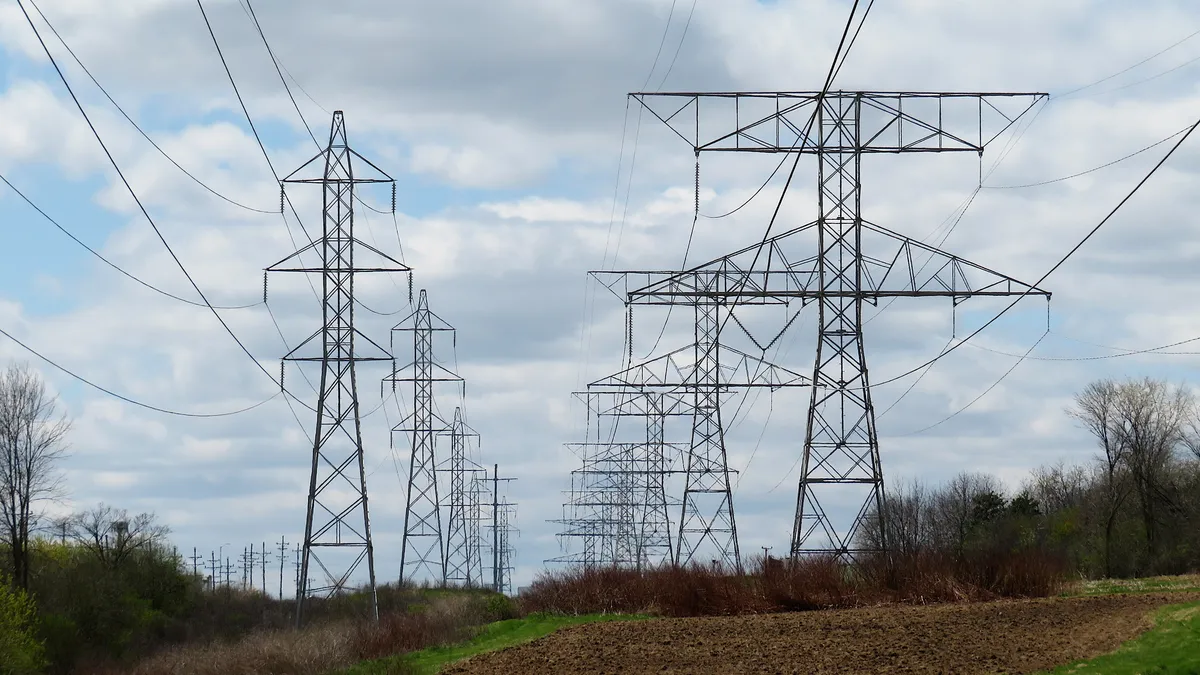Dive Brief:
-
Capacity prices across most of the PJM Interconnection fell 32% to a 10-year low of $34.13/MW-day from $50/MW-day in the previous auction, possibly reflecting recent rule changes, the grid operator said Tuesday.
-
PJM bought 144,871 MW of capacity for the capacity year that starts June 1, 2023, for $2.2 billion, down from $4 billion in the last auction, according to the grid operator. About 160,874 MW was offered in the auction, a decrease from last year’s auction of about 11,333 MW.
-
The auction featured a surge in cleared nuclear and new gas-fired generation, with a drop in coal-fired generation, according to Scott Niemann, a director at ESAI Power, a consulting firm.
Dive Insight:
“Basically, with a lot of supply coming in, and no significant change in demand, prices were going to go down,” Niemann said Wednesday. “And to keep prices from falling further, a lot of additional capacity that cleared in ’22/’23 had to go unsold in this auction, and most of that seems to have come from coal.”
The lower capacity prices were largely in line with analysts’ forecasts.
“We expected a relatively low clearing price for this auction (as well as the next auction in December) compared to the last few years, which makes sense given the energy market conditions, Dominion's [fixed resource requirement] decision, and how relatively long the PJM market remains,” Bill Dugan, Customized Energy Solutions’ director of optimization for wholesale services, said in an email Tuesday.
The auction results, with an increase in emissions-free resources winning capacity obligations, is a sign the energy transition is underway in PJM, according to the grid operator.
“We are experiencing the continuing transition to lower carbon emitting resources, and we see that trend continuing with this auction,” Stu Bresler, PJM senior vice president of market services, said in a conference call with reporters.
PJM typically holds annual capacity auctions, called base residual auctions, to secure capacity three years in advance. The failure to win capacity obligations can be a factor in power plant owners deciding to retire those generating units.
All 16,175 MW of Constellation Energy’s nuclear capacity in PJM cleared the auction, up from 9,900 MW last year, when the company’s Byron, Dresden and Quad Cities nuclear plants failed to land capacity obligations, the company said in a Securities and Exchange Commission filing Tuesday.
The Byron and Dresden plants are supported by new Illinois subsidies; the Quad Cities plant near Cordova, Illinois, failed to clear in the last auction because of a strict minimum offer price rule that has since been loosened, Niemann noted.
Also, about 1,870 MW of solar capacity cleared the auction, up from about 1,510 MW in the last auction, according to PJM, which runs the electric system and wholesale power markets in 13 Mid-Atlantic and Midwestern states plus the District of Columbia.
Cleared wind resources dipped to about 1,295 MW from 1,730 MW in the last auction, partly reflecting fewer offers, according to Bresler.
Cleared steam resources, which are mainly coal-fired, fell 21%, to about 27,680 MW from 34,870 MW. The drop reflected the retirement of coal-fired power plants, according to PJM.
Overall, about 21.6 GW of coal capacity cleared in the auction, down from 27.4 GW and 39 GW in the previous two auctions, according to Niemann. Looking ahead, coal ash and ozone regulations could drive additional coal units to shut down this decade, he said.
Combined-cycle units cleared 48,030 MW, up about 8% from the last auction, and combustion-turbine units cleared 19,080 MW, down 5%. Typically, combined-cycle units are more efficient than combustion turbines, Bresler noted.
Cleared energy efficiency resources increased by 660 MW to 5,471 MW, but that was offset by a 716 MW decrease in demand response, to 8,096 MW, according to PJM. The drop in demand response resources may have been driven by the auction’s compressed schedule, giving demand response companies less time to line up customers, according to Bresler.
About 3,735 MW of new generation cleared in the auction, including about 405 MW of uprates. The new generation likely included the Jackson and Three Rivers gas-fired power plants under development in Illinois, according to Niemann.
It appears that no battery storage cleared in the auction, possibly reflecting delays in PJM’s interconnection queue and supply chain problems, Niemann noted.
Two rule changes — the use of a “narrow” MOPR and the use of the “effective load carrying capability” method to determine the capacity value of wind, solar and storage resources — likely affected the auction results, Bresler said.
The MOPR, which limits how low certain resources can bid in the auction, was applied to 79 MW, potentially contributing to lower overall capacity prices, according to Bresler.
When combined with capacity utilities procured outside the auction, PJM expects it will have a 20.3% reserve margin — a buffer of additional capacity above forecast peak load to handle unexpected events — compared with a 14.8% target margin.
Capacity prices in most of the Mid-Atlantic Area Council region, which covers New Jersey, most of Pennsylvania and parts of Maryland, fell to $49.50/MW-day from $95/MW-day in the last auction. The higher price compared with that seen in the rest of PJM is driven by transmission constraints, according to Bresler.
Meanwhile, prices in Baltimore Gas & Electric’s zone and Delmarva Power South came in at $69.95/MW-day, compared with $126.50/MW-day and $50/MW-day, respectively, in the last auction.














